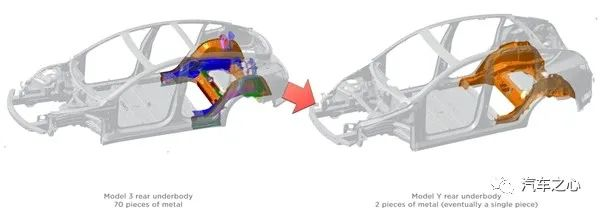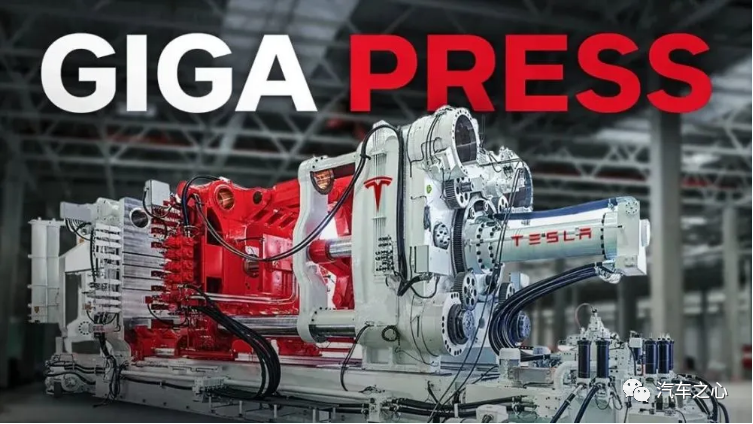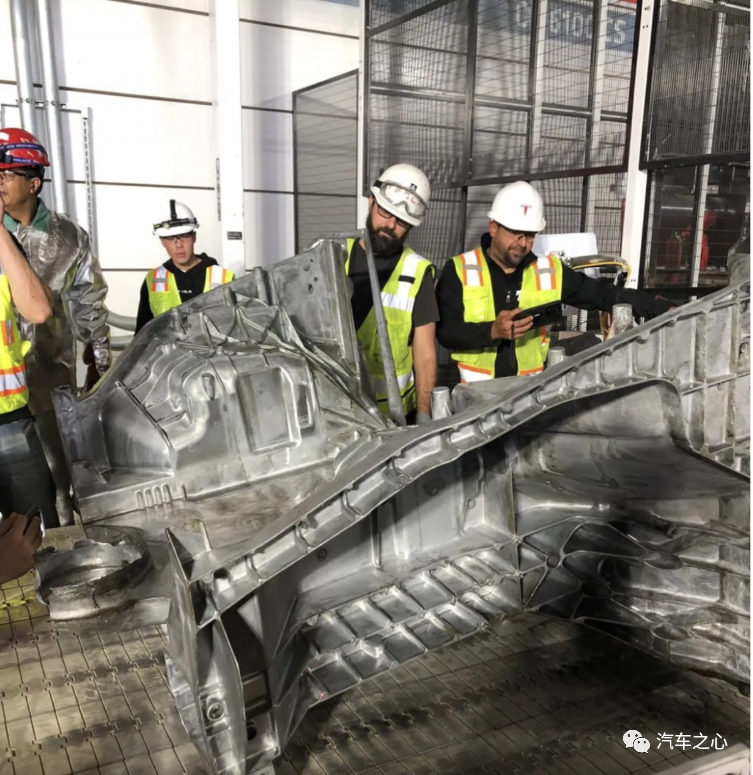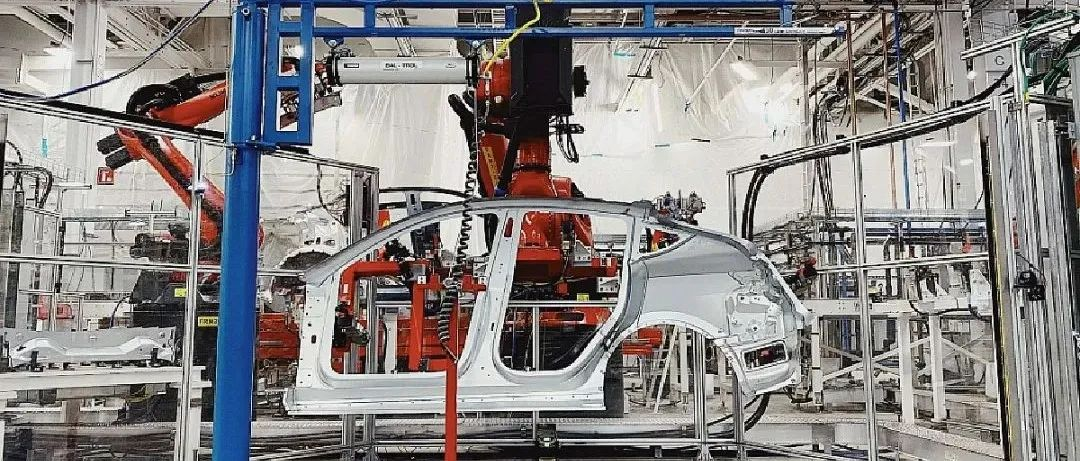Author: Dude
On January 22, Guangdong Hongtu announced the successful launch of its 6800-ton new energy vehicle chassis integrated cast structure part, and will cooperate with Lijing Technology to develop a 12000-ton casting machine. The relevant persons in charge of NIO and XPeng attended Hongtu Technology’s press conference.
This is noteworthy information, and the reform process of the hundred-year-old manufacturing of automobiles has taken a big step forward.

A road to integrated casting, opened by Tesla, shows the magic and charm of engineering, fully demonstrating the industrial efficiency of fragmentation. The Model Y produced by casting, which compresses more than 70 original components into a single component, reduces costs by 20%, and the casting process can recycle waste, achieving almost 100% utilization of raw materials.
These unprecedented engineering explorations are a revolutionary change in the traditional processes of stamping, welding, painting, and final assembly.
This is a combination of production efficiency and lightweighting, and more and more car companies are moving towards an integrated road. Follow-up companies include: NIO, XPeng, Idean, GAC (Gaohe), Volvo, and Mercedes-Benz (EQXX).
In manufacturing, an immutable theorem is that hard work and laborious work cannot create massive profits. Can the appearance of integrated casting wash away this stereotype and create a set of puzzle keys for car companies?
While witnessing the success of Tesla’s case, we must also be aware that this is a new technology that involves a series of factors such as materials, moulds, equipment, etc., and there is huge uncertainty in front of it.
Manufacturing is Tesla’s core competitiveness
Tesla has set a trend in intelligence, and leads in manufacturing.
Musk even stated that production and manufacturing are Tesla’s core competitiveness. “Large castings, structural batteries, 4680 batteries, and other aspects will help us continue to reduce product costs.”
Tesla has always adhered to the concept of “using machines to produce machines”, and all starting points are aimed at shortening the radius from materials to final products. In the process of production and manufacturing, Tesla has made many pioneering reforms, such as the automated assembly production line for Model 3, with transportation, loading, and component welding all on an automated line. It has been especially successful in the case of integrated casting.
 The Tesla Model Y adopts an integrated casting rear floor assembly, reducing the weight of the lower body assembly by 30%, increasing the corresponding range by 14%, and also reducing manufacturing costs by 40% compared to before.
The Tesla Model Y adopts an integrated casting rear floor assembly, reducing the weight of the lower body assembly by 30%, increasing the corresponding range by 14%, and also reducing manufacturing costs by 40% compared to before.
The utilization rate of remaining corner materials can reach 90%. At the same time, an integrated rear floor also has the benefit of avoiding the requirements of shaping. Only focusing on thickness and performance is needed.
In addition, integrated body casting can reduce processes such as welding and riveting, and reduce the deployment complexity of production lines while reducing maintenance costs in the later stages. For example, in the case of Tesla’s Model Y, one rear floor casting machine can replace 300 welding robots, greatly reducing the complexity of factory deployment.
However, integrated casting is not a plug-and-play solution, and there are many difficulties to overcome. According to Hongtu Technology’s communication meeting in January this year, the main difficulties of integrated casting products are in equipment, materials, technology, and molds. It requires a large-sized (above 6000T) casting equipment, and due to the large product volume, it is difficult to perform heat treatment. Breakthroughs are needed in material development, and production technology and molds will affect the product yield.
Traditional die-cast aluminum alloy parts require solid solution and aging heat treatment to meet the strength, durability, and impact resistance required by body performance. However, during the heat treatment process, die-casting parts are prone to dimensional deformation and surface defects. This requires the development of a heat-free material.
Industry insiders revealed to Autohome that heat-free treatment requires an increase in compressive strength. Currently, heat-free alloy materials are mainly represented by American Aluminum and Rheinfield in Germany, and domestic companies such as Li Zhong Group are relatively advanced.
In fact, Tesla has also done a lot of material breakthroughs. They first poached top aluminum alloy expert Charles Kuehmann from Apple and put him in charge of both SpaceX’s Dragon spacecraft and Tesla’s material engineering team. Under Kuehmann’s leadership, Tesla quickly developed an exclusive aluminum alloy formulation for integrated casting technology, which allowed the overall mechanical performance to increase by 20-30% and meet collision requirements. Furthermore, die-castings don’t require heat treatment and can directly enter the next process, saving more than 6 hours.
Mikael Fermer, head of the Volvo Vehicle Platform Architecture, also stated in a media interview that:”We are currently developing a heat-free aluminum alloy material at Volvo, as the alloy would be very brittle like potato chips without it. We are facing difficulties in using a sustainable approach, as we need a large amount of recycled aluminum in the alloy. We are researching the use of 50% recycled aluminum, as well as alloys with 100% recycled aluminum, but these alloys haven’t met our target standards yet.”
“It is evident that the impact of heat-free materials on integrated die casting is tremendous. Additionally, molds and casting processes also play an important role and have high precision requirements that affect the yield rate, especially for large tonnage molds.”
“Considering that this is a groundbreaking technology and process, why have traditional car companies, who are known for their manufacturing capabilities, not yet embraced it? On the one hand, their main sales force is still fueled by combustion engines with no strong demand for lightweight and increased range vehicles, and no breakthrough progress in reducing fuel consumption. On the other hand, traditional car companies need to see positive results and form a sufficient scale effect in order to adopt new technologies.”
“At the same time, integrated die-casting needs to be applied to a completely new platform, with the supplier involved in the design process from the beginning, to decide on the size and performance. In addition, part of the production line needs to be upgraded to accommodate integrated die-casting. All the traditional supply chain links related to stamping and welding, such as supplier review, procurement, manufacture of stamping dies, and use of stamping equipment, welding fixtures, gun use, development of gauges, and logistics transportation of components, are no longer necessary. Even when traditional car companies manufacture new energy vehicles, they prioritize the reuse of investment equipment for combustion engines. If they can reuse it, they continue to use the stamping and welding process.”
“According to the report from CICC, with an annual production of 100,000 vehicles, the total investment in the stamping and welding process is approximately 520 million yuan. If the entire vehicle is produced using the integrated die-casting process, the total investment in the corresponding process is 710 million yuan, which is 36% higher than the investment in the traditional stamping and welding process.”
“Due to the above reasons, integrated die-casting is a financial calculation that traditional car companies need to carefully consider. But calculating costs does not mean they are not paying attention and keeping up with the trends. According to reports, Geely, FAW, and Dongfeng are all laying out plans to adopt integrated die-casting, and even Huawei and Xiaomi are considering following suit.”
“Tesla’s success in producing the Model Y has demonstrated the increased production efficiency and effective cost reduction brought about by integrated die-casting. As new forces embracing new technologies, they are standing at the forefront.”
“On October 18, 2021, NIO announced the successful development of heat-free materials for large-scale die-casting.”This is the first time for Chinese car manufacturers to verify and apply this material to large structural parts.
Compared with conventional aluminum alloy die-castings that require solid solution and aging heat treatment to meet the strength, durability, and impact resistance required for vehicle performance, the new heat treatment-free material developed by NIO and its partners can avoid the size deformation and surface defects caused by traditional die-casting during the heat treatment process, making large-body die-casting possible.
The development of NIO’s heat treatment-free material took more than a year and underwent thousands of tests and verifications at different levels, including materials, parts, systems, and entire vehicles, to ensure the high quality and stability of the vehicle performance.
It is reported that the new material will be applied to NIO’s second-generation platform models.
At last year’s NIO Day, NIO released its new model ET5, which uses NIO’s independently developed four-piston aluminum alloy integrated casting caliper. According to an industry insider who spoke to the Automotive News, the cost of integrated casting currently accounts for around RMB 2,000 per vehicle.
At present, NIO does not produce integrated casting itself but has engaged two suppliers, Nantong Xiongbang and Chongqing Melixing, to support the ET5’s integrated casting. Nantong Xiongbang has already produced samples and will have half a year of on-vehicle testing time. Melixing’s equipment began installation at the end of last year, and the first casting was expected to take place in April 2022.
Unlike NIO’s complete reliance on suppliers, Xpeng has taken a different approach.
In the Zhaoqing factory, Xpeng chose to adopt Hongtu’s integrated casting solution, while the planning of the Xpeng Wuhan industrial base shows that Xpeng Automobile will establish stamping, welding, painting, final assembly, battery, and motor workshops, as well as an integrated casting process workshop. Xpeng Automotive will introduce super large integrated casting islands.
In addition, Huaren Yutong and the National Engineering Research Center for Light Alloy have reached a strategic cooperation in the development of new materials and processes, low-carbon light alloy industrialization, talent training, and other aspects, and have made substantial progress at the level of technology development. The low-carbon aluminum alloy for ultra-large castings, jointly developed by both parties and named TechCastTM, will be mass-produced in subsequent models of GAC Group’s high-end automobiles.
Unlimited potential of integrated casting
Integrated casting showcases the magic and charm of engineering, greatly improving the lightweighting of automobiles.

It is reported that Tesla’s yield for rear floor panels has reached 40%-60%. In addition to the already mass-produced rear floor panels, the front floor panels have been completed, and the middle floor panels will take another 2-3 years. The implementation of the white body integrated casting will take at least 5-8 years.As more and more automakers adopt the integrated casting process, the penetration rate of this technology will continue to increase. In addition, the integrated casting process is gradually extending to the central floor and battery trays, which will result in higher overall vehicle costs.
It can be said that integrated casting will be an engineering pathway with unlimited potential.
This article is a translation by ChatGPT of a Chinese report from 42HOW. If you have any questions about it, please email bd@42how.com.
